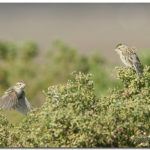
Sparrows are so difficult to identify many birders are content to lump them with similar drab birds, calling them, “LBBs,” short for, “Little Brown Birds.” However, there are ways through the confusing maze of “LBB” identification, and Riverbank’s Ralph Baker seems to have found one or two.
Though he’s been birding only two years, Baker has impressed veteran birders with his sharp eye and quick learning ability. He recently found a very rare Clay-colored Sparrow in Stanislaus County.
“Even though I’ve only been birding two years, I’ve always looked at birds,” says Baker. “I use the target method most of the time and a version of the Peterson method.”
So it was that Baker was looking for “Blue Geese” (a distinctive plumage of Ross and Snow Geese) from the U.S. Fish and Wildlife viewing platform on Beckwith Road west of Modesto, when he noticed a sparrow that didn’t look quite like the sparrows he’d expect to see at that location and time of the year.
“I saw the bird foraging below the viewing platform, almost below my feet. The first thing that went through my mind was, ‘That bird is WAY too small to be a crowned sparrow and there is no streaking on the nape so it can’t be a Savannah Sparrow!’ I knew I had something interesting even before I got on it with my bins.”
In his two years birding, Ralph Baker has developed a good understanding of the local birding “background,” which consists of the expected common birds in a given habitat at a given time of the year. Thus, he noticed almost immediately that the Clay-colored Sparrow did not fit the pattern of the expected, “LBB.” Despite having never seen a Clay-colored Sparrow, Baker knew enough to focus on key features of the bird that would enable a reliable identification, especially the nape, rump, crown and breast.
“When I see a new bird I like to study it as long as possible, or until I’m satisfied with the look I’ve gotten. I try to memorize as many field marks as possible. Then, because I only rarely carry a guide into the field I check my guides when I get back to the car (I keep the Sibley and National Geographic Western guides in my birding bag). If I’m still not 100% on the ID I check several other sources when I get home. If I’m still unsure I consult with other birders.”
Because Baker had trained himself to observe closely, he was able to provide a convincing written description of the rare bird and spread the word via the Internet. When other birders rushed to the viewing platform, they were able to relocate what turned out to be only the third Stanislaus County record for Clay-colored Sparrow.
The Patagonia Roadside Rest Stop Effect
Though he’d already seen one of the two previous Stanislaus County records of Clay-colored Sparrow, Harold Reeve also made several visits to the Beckwith Road viewing platform, not only to confirm the species identification but just to enjoy the rare visitor. Reeve has seen nearly 300 bird species in Stanislaus County, and his wife Sharon almost as many.
On one visit to the platform, the Reeves had relocated the Clay-colored Sparrow when Sharon Reeve noticed another odd-looking LBB.
“If that’s the Clay-colored Sparrow,” she said, nodding toward the first bird, “What’s that,” she asked, pointing to the second bird.
Indeed, despite the odds against such an occurrence, the second bird was also a Clay-colored Sparrow. The second rare bird in the same location confirmed the, “Patagonia Roadside Rest Stop Effect,” a theorem which postulates that when a bird is rare enough to draw multiple experienced birders to a given location there is an increased probability of finding even more rare birds in the same location. Finding the second bird was almost as exciting as finding the first.
Like many birders who catch the birding bug, Ralph Baker now keeps multiple lists of birds he’s seen, including the sacrosanct, “life list,” a list of every bird species seen in a birder’s lifetime. The Clay-colored Sparrow was “life bird” number 279 for Baker, and “county bird” number 211, impressive totals for only two years of birding.
Even more impressive, Ralph Baker was able to add to local knowledge of bird distribution while providing many others with the ongoing joy of birding. He’s now on the quest for life bird number 280, and enjoying all the other birds he sees along the way.

If anyone is interested, I have a 4-mile hike along the Tuolumne River on Saturday, March 24th at 9:30 AM. Meet at the parking lot of the American Legion Building, 1001 S. Santa Cruz Avenue, Modesto.
This is a popular walk which I lead for the Sierra Club and I’m sure anyone would enjoy it. Dogs and children welcome.
Maybe you can even see some birds!
Info. Dorothy 549-9155